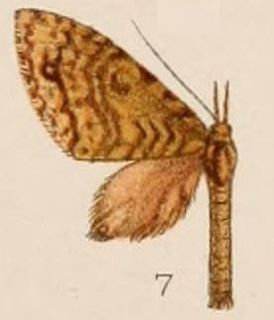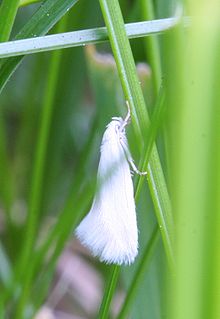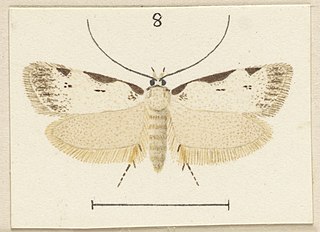
Epermeniidae or the fringe-tufted moths is a family of insects in the lepidopteran order with about 14 genera. Previously they have been divided in two subfamilies Epermeniinae and Ochromolopinae but this is no longer maintained since the last group is probably hierarchically nested within the first. They are presently placed in their own superfamily but have previously been placed among the Yponomeutoidea or Copromorphoidea with which they share some features. Their systematic placement among the apoditrysian group "Obtectomera" is however uncertain. They show some morphological similarities to the "plume moths", for example the wing fringe has similar groups of scales. There are also some similarities to Schreckensteinioidea, for example spiny legs and at least in some species an open-network cocoon. The genus Thambotricha from New Zealand may be the sister group of all other extant members. The most important genera are Epermenia, Ochromolopis and Gnathifera. The group has been extensively revised and catalogued by Dr Reinhard Gaedike.

The Batrachedridae are a small family of tiny moths. These are small, slender moths which rest with their wings wrapped tightly around their bodies.

Batrachedra is the largest genus in the moth family Batrachedridae, with representatives all over the world. The early stages of most species are unknown. The genus name is derived from the Greek words batrachos, 'frog', and edra, 'seat', referring to the frog-like resting posture of the adult moths. As of 2018 at least some 114 species are known to belong to the genus.

Halone is a genus of moths in the subfamily Arctiinae from southern Asia and Australia. The genus was erected by Francis Walker in 1854.

Praxis porphyretica, the brown praxis, is a moth of the family Noctuidae. The species was first described by Achille Guenée in 1858. It is found in the Australian Capital Territory, New South Wales, Queensland, Tasmania and Victoria.

Praxis edwardsii, or Edward's praxis, is a moth of the family Noctuidae. The species was first described by Achille Guenée in 1852. It is found in Australia in Queensland, New South Wales, the Australian Capital Territory, Victoria, Tasmania, South Australia and Western Australia.

Praxis is a genus of moths of the family Noctuidae. The genus was erected by Achille Guenée in 1852.
Prorocopis is a genus of moths of the family Noctuidae. The genus was described by Meyrick in 1897. All the species in the genus are known from Australia.

Sauris is a genus of moths in the family Geometridae erected by Achille Guenée in 1857.

Anatrachyntis is a genus of moths in the family Cosmopterigidae. Some authors include it in Pyroderces.

Labdia is a genus of moths in the family Cosmopterigidae.

The Depressariinae – sometimes spelled "Depressiinae" in error – are a subfamily of moths in the superfamily Gelechioidea. Like their relatives therein, their exact relationships are not yet very well resolved. It has been considered part of family Elachistidae sensu lato or included in an expanded Oecophoridae. In modern classifications they are treated as the distinct gelechioid family Depressariidae.

Elachista is a genus of gelechioid moths described by Georg Friedrich Treitschke in 1833. It is the type genus of the grass-miner moth family (Elachistidae). This family is sometimes circumscribed very loosely, including for example the Agonoxenidae and Ethmiidae which seem to be quite distinct among the Gelechioidea, as well as other lineages which are widely held to be closer to Oecophora than to Elachista and are thus placed in the concealer moth family Oecophoridae here.

Izatha balanophora is a moth of the family Oecophoridae. It is endemic to New Zealand, where it is widespread in the North Island. Larvae live off the dead bark of kānuka. The adult moths are on the wing during December to March.

Prorocopis melanochorda is a moth of the family Noctuidae first described by Meyrick in 1897. It is found in Australia.

Xyloryctidae is a family of moths contained within the superfamily Gelechioidea described by Edward Meyrick in 1890. Most genera are found in the Indo-Australian region. While many of these moths are tiny, some members of the family grow to a wingspan of up to 66 mm, making them giants among the micromoths.

Gracillariinae are a subfamily of moths which was described by Henry Tibbats Stainton in 1854.
Gnathifera is a genus of moths in the family Epermeniidae.















